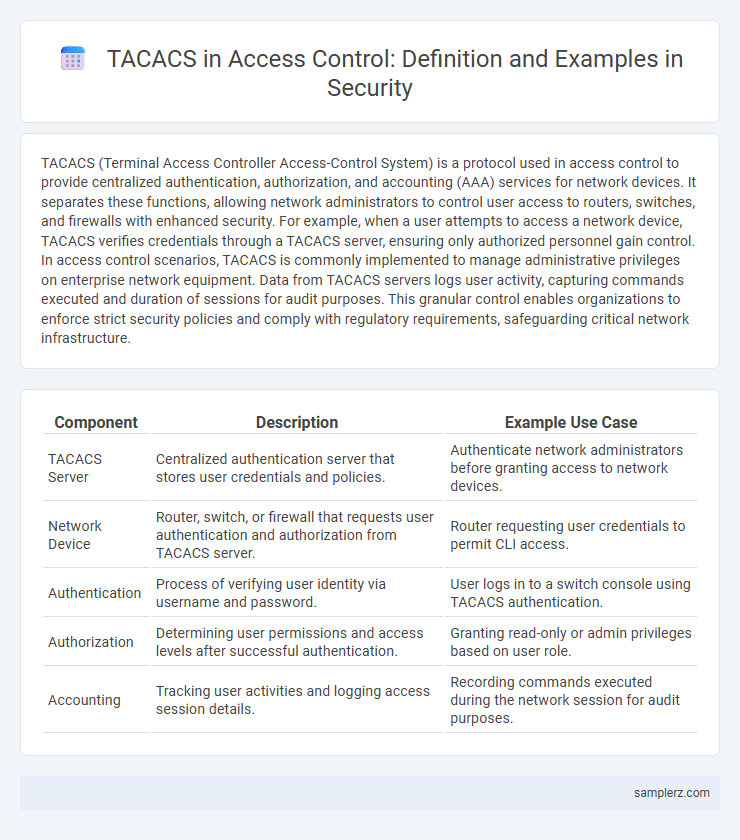TACACS (Terminal Access Controller Access-Control System) is a protocol used in access control to provide centralized authentication, authorization, and accounting (AAA) services for network devices. It separates these functions, allowing network administrators to control user access to routers, switches, and firewalls with enhanced security. For example, when a user attempts to access a network device, TACACS verifies credentials through a TACACS server, ensuring only authorized personnel gain control. In access control scenarios, TACACS is commonly implemented to manage administrative privileges on enterprise network equipment. Data from TACACS servers logs user activity, capturing commands executed and duration of sessions for audit purposes. This granular control enables organizations to enforce strict security policies and comply with regulatory requirements, safeguarding critical network infrastructure.
Table of Comparison
| Component | Description | Example Use Case |
|---|---|---|
| TACACS Server | Centralized authentication server that stores user credentials and policies. | Authenticate network administrators before granting access to network devices. |
| Network Device | Router, switch, or firewall that requests user authentication and authorization from TACACS server. | Router requesting user credentials to permit CLI access. |
| Authentication | Process of verifying user identity via username and password. | User logs in to a switch console using TACACS authentication. |
| Authorization | Determining user permissions and access levels after successful authentication. | Granting read-only or admin privileges based on user role. |
| Accounting | Tracking user activities and logging access session details. | Recording commands executed during the network session for audit purposes. |
Understanding TACACS: Definition and Core Functions
TACACS (Terminal Access Controller Access-Control System) is a protocol designed to provide centralized authentication, authorization, and accounting (AAA) for network devices. It separates these functions to enhance security and control by managing user access policies and tracking user activities across routers, switches, and firewalls. TACACS ensures that only authorized personnel gain access to critical infrastructure while maintaining detailed logs for audit and compliance purposes.
The Role of TACACS in Modern Access Control Systems
TACACS (Terminal Access Controller Access-Control System) plays a critical role in modern access control systems by providing centralized authentication, authorization, and accounting for network devices. It enhances security by enabling granular access management, ensuring that only authorized users gain specific privileges on network resources. Organizations rely on TACACS to maintain detailed audit trails and enforce consistent security policies across diverse hardware and software environments.
How TACACS Enhances Authentication, Authorization, and Accounting
TACACS enhances authentication by securely verifying user credentials through encrypted communication between network devices and the TACACS+ server, preventing interception or tampering. It strengthens authorization by providing granular control over user permissions, allowing administrators to define specific access rights for different roles and devices. TACACS also improves accounting by logging detailed user activities and command executions, facilitating comprehensive auditing and accountability in network security management.
Real-World Example: Implementing TACACS in Enterprise Networks
In enterprise networks, TACACS (Terminal Access Controller Access-Control System) is widely implemented to enhance access control by centralizing authentication, authorization, and accounting (AAA) for network devices. Cisco routers and switches commonly integrate TACACS+ servers to manage user credentials and enforce role-based access policies, ensuring only authorized personnel can configure or access critical infrastructure. This centralized approach not only improves security through granular control but also simplifies auditing and compliance reporting across large-scale environments.
TACACS vs. RADIUS: Key Differences in Access Control
TACACS (Terminal Access Controller Access-Control System) provides enhanced access control by separating authentication, authorization, and accounting functions, allowing granular administrative control over network devices. Unlike RADIUS, which combines these processes and primarily targets network access across diverse environments, TACACS+ uses TCP for reliable communication and stronger encryption, offering superior security for device management. TACACS+ excels in complex network environments due to its detailed command authorization capabilities and flexible policy enforcement compared to RADIUS's simpler user authentication focus.
Step-by-Step Example: Configuring TACACS on Network Devices
Configuring TACACS for access control involves first setting up the TACACS server with defined user roles and permissions to manage centralized authentication. Next, network devices like routers or switches are configured with the TACACS server IP address and shared secret key to establish secure communication. Finally, device access policies are enforced by enabling TACACS authentication methods, ensuring all login attempts are verified against the TACACS server for enhanced security and accountability.
Case Study: Securing Remote Access with TACACS
TACACS (Terminal Access Controller Access-Control System) enhances remote access security by centralizing authentication and authorization for network devices. In a case study, a multinational enterprise implemented TACACS to manage access across diverse locations, resulting in streamlined policy enforcement and reduced unauthorized access incidents. The protocol's granular control and encrypted communication ensured robust protection against credential interception and privilege escalation.
Monitoring and Auditing Access Events with TACACS
TACACS enhances access control by providing detailed monitoring and auditing of access events, capturing user activities with precise timestamps and command-level logs. This granularity enables security teams to trace unauthorized access attempts and track administrative changes across network devices. Centralized logging through TACACS improves compliance reporting and supports forensic investigations effectively.
Best Practices for Deploying TACACS in Access Control Scenarios
Implementing TACACS in access control requires encrypting the entire authentication process to ensure secure communication between network devices and the TACACS server. Centralized management of user access policies streamlines authorization and accountability, enhancing security through detailed logging and auditing of administrative activities. Deploying TACACS in segmented network environments limits exposure and reduces risks, aligning with the principle of least privilege for robust access control.
Addressing Vulnerabilities: Common TACACS Security Pitfalls and Solutions
TACACS vulnerabilities often stem from improper key management and outdated protocol versions, exposing network devices to unauthorized access and interception risks. Implementing strong, complex shared secrets along with TACACS+ instead of legacy TACACS reduces susceptibility to brute force and replay attacks. Regularly updating TACACS server software and enforcing strict access control lists help mitigate privilege escalation and man-in-the-middle vulnerabilities.

example of TACACS in access control Infographic
 samplerz.com
samplerz.com